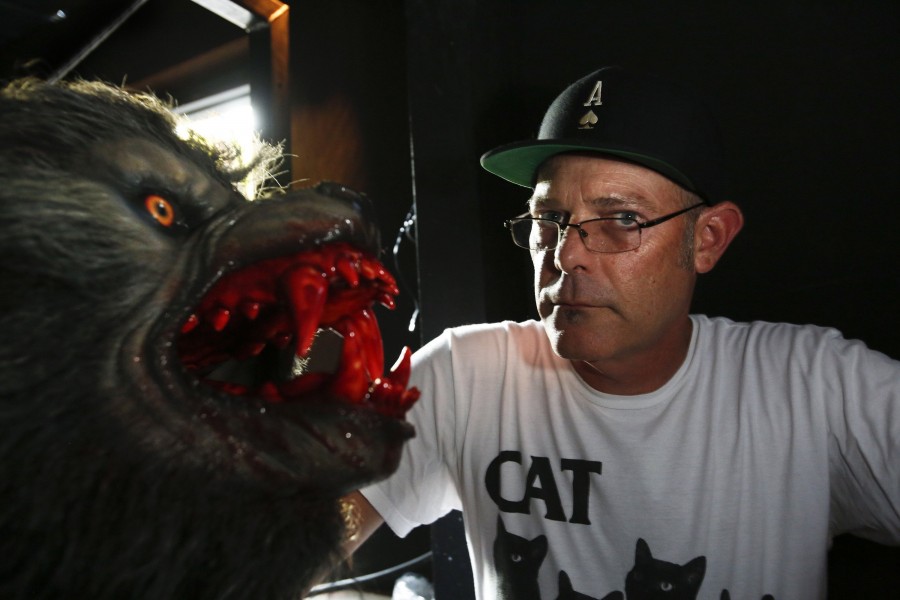Theme parks’ Halloween scare tactics becoming frightfully high-tech
John Murdy, executive producer of Halloween Horror Nights at Universal Studios Hollywood, with one of many werewolves during a tour of the mazes that are being set up around the theme of the horror movie “An American Werewolf in London” in Universal City, Calif.
October 1, 2014
By Hugo Martín
To re-create a bloody scene from the 1981 horror flick “American Werewolf in London,” crews at Universal Studios Hollywood installed computer-controlled strobe lights behind the walls of a dark maze to simulate the flash of bullets.
An actor wearing a rubber prosthesis connected to a tube of fake blood around his neck reenacts a gruesome execution. It all plays out to the sound of gunfire and blood-curdling screams, blasted from speakers in the ceiling.
The technology used at gore- and chaos-filled mazes, haunted houses and other scare shows has advanced dramatically from a decade ago, when rubber masks and fog machines represented the most advanced special effects used to frighten guests.
Now the scares are created with the help of 30-channel audio mixers, animatronics, computer-controlled lights and video monitors.
“We’ve made a quantum leap in technology, especially this year,” said John Murdy, director of Halloween Horror Nights, the annual fright fest at Universal Studios that draws thousands of scare fans over 22 nights leading up to Halloween.
Scare masters such as Murdy say such high-tech gadgets are a must to put a genuine shock into teens who have become thick-skinned from daily exposure to gore and violence in movies and video games.
“The attention span today is much shorter,” said Lara Hanneman, technical director for entertainment at Knott’s Berry Farm, a theme park in Buena Park, Calif. “We need to make the scenes move faster.”
Knott’s, which recast its park as Knott’s Scary Farm, may be taking the biggest leap in the use of technology this year by arming guests with infrared-emitting rifles to hunt zombies through a six-acre section of the park.
“The idea really spawned from video games,” said Jon Cooke, the lead props designer at Knott’s.
After all, bigger scares mean bigger crowds — and higher revenue.
Across the country, Halloween attractions such as haunted houses, theme park mazes and festivals generated more than $300 million last year, a slight increase over 2012, according to the trade group Haunted Attraction Assn.
As many as 36 percent of Americans are expected to attend some type of Halloween attraction this year, the group estimates.
Theme parks don’t disclose attendance numbers, but Dark Harbor, a Halloween event created by the operators of the Queen Mary in Long Beach, had more than 103,000 visitors last year, a 40 percent increase over the previous year, according to Long Beach officials.
Knott’s Berry Farm estimates that its Halloween attractions draw about 15 percent of its annual attendance.
At the opening night of Universal Studios’ Halloween Horror Nights, the crowds were so big that visitors waited in line for up to 90 minutes for the most popular mazes.
Despite the long lines, horror fans say the scares were worth the wait.
“If they were going for realistic, they got it,” Josh Ault said after visiting the Universal maze “Alien versus Predator” with his wife, Liz.
The most frightening scene, they said, showed a woman screaming while being eaten alive by an alien. “It’s pretty jarring,” said Liz Ault.
To keep visitors coming, the operators of Halloween scare fests say they are under pressure to come up with more realistic special effects each year.
“The industry is evolving,” said John Eslich, president of the Haunted Attraction Association. “A lot of the electronics and controller prices have been on the downward slide so that more mainstream parks can afford them.”
At the annual Halloween event at the Queen Mary, work crews installed tiny lights, the size of lipstick containers, into the walls and ceilings of a maze called “Soulmate” to create the effect of flickering lights and candle flames, said J.J. Wickham, the creative director for Dark Harbor.
“We can control the lights to go off and on throughout the night,” she said.
At Universal Studios Hollywood, workers at a central control center can watch video feeds from every maze and attraction to see if visitors are stuck in a bottleneck or technology is malfunctioning.
“We always think that the technology will make our job easier, but it makes it just as complicated as always,” Hanneman said.
The special effects in the “American Werewolf in London” maze combines high-tech and low-tech scare tactics.
For example, the worker who controls a life-size werewolf that lunges out at guests near the end of the maze can see when guests get close through video monitors installed behind the scenes.
“We have never done a scare that is this complicated,” Murdy said.
As for low-tech scares, he said that thick string hangs from the ceiling throughout the maze to distract and disorient guests stumbling around in the dark.
At Knott’s Berry Farm, the area known as Camp Snoopy will be converted this year to a land called “Special Ops: Infected.” About 135 actors, made up to look like zombies, will wander throughout the area while groups of 12 park visitors enter for periods of about 10 minutes, armed with specially made infrared-emitting rifles.
Sound effects emitted by the rifles signal when park visitors have successfully shot a zombie. But the weapons will also signal when a zombie comes too close, temporarily deactivating the rifle and endangering the group.
“It’s always a challenge to be different and innovative,” Hanneman said.

©2014 Los Angeles Times
Visit the Los Angeles Times at www.latimes.com
Distributed by MCT Information Services








